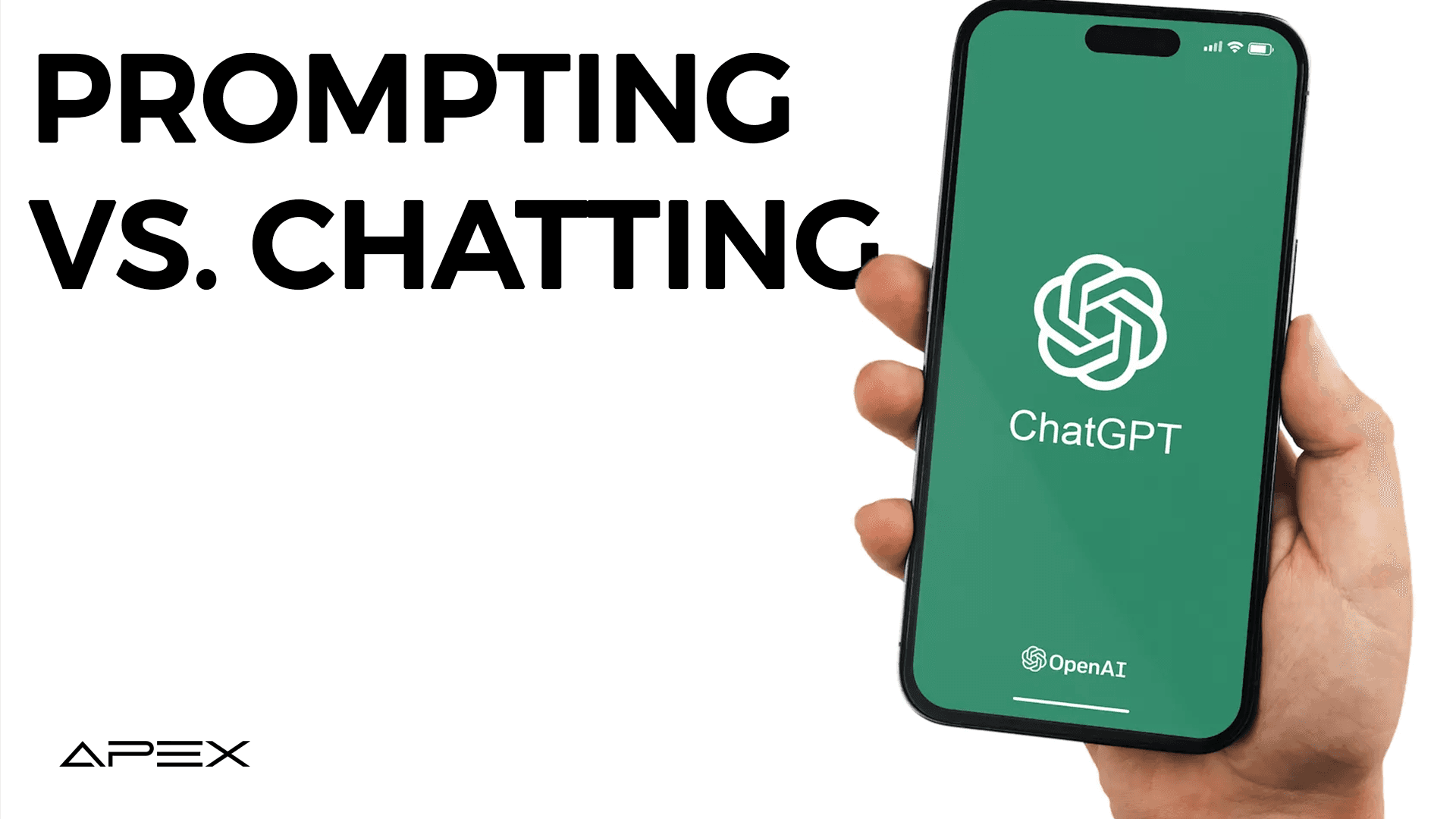Today, let's delve into two primary methods for interacting with AI: Prompting and Chatting. Each serves a unique purpose, depending on your needs and goals. Understanding when to use each can significantly enhance your productivity and creativity.
Prompting: Precision in Action
Prompting is ideal when you have a specific outcome in mind. It involves providing the AI with clear, detailed instructions to generate targeted content. For instance, if you're crafting a blog post on "5 Tips for Higher Quality Leads", you already know the problem, main points, and sub-points. Giving the AI these details can efficiently draft the content for you.
Prompting is particularly effective when you:
Have a clear goal and structure in mind
Need precise and focused results
Want to expand on pre-existing ideas
At APEX, most of our prompting is designed around the PODS and RACE framework, which we also share with customers to develop better copies for their social media, blogs, or even ad copies.
Chatting: Exploring the Unknown
Chatting with AI, on the other hand, is more exploratory. It’s perfect for when you’re venturing into new topics or need to brainstorm. Engaging in a conversational exchange with AI allows you to uncover new insights and ideas.
Chatting serves two primary functions:
Priming: By asking broad questions, you guide the AI’s thinking, ensuring its responses align with your interests.
Discovery: Chat lets you explore various angles and gather information when unfamiliar with a topic. You can always ask the AI to summarize the key points afterward.
For example, when I explored writing a post on "How To Write Lead Generating Content Using HBR’s Elements Of Value Pyramid," I wasn't well-versed in the framework. I started by asking the AI to explain the basics, then used its responses to generate ideas. This method turned the chat log into a treasure trove of content ideas.
Chatting is ideal when you:
Are exploring a new subject.
Want to find unique perspectives.
Need to build context before diving into writing.
Chain-of-Thought Prompting: Enhancing AI's Reasoning Capabilities
Chain-of-Thought (CoT) prompting, introduced by Wei et al. (2022), is a technique that significantly improves AI's ability to handle complex reasoning tasks by breaking down the problem into intermediate logical steps. This method involves guiding the AI through a series of thought processes before concluding.
For instance, when solving a problem involving arithmetic or logical reasoning, the AI is prompted to explain each step of its thought process, ensuring a more accurate and detailed response. This approach can be combined with few-shot prompting, where the AI is given a few examples to learn from, thereby improving its performance on intricate tasks.
By fostering a step-by-step reasoning approach, CoT prompting allows AI to mimic human-like analytical thinking better and provides more reliable and coherent outputs.
Example of Chain-of-Thought Prompting: Analyzing Business Profit Margins
Task: Calculate the profit margin for a product.
Prompt: "A company sells a product for $200. The cost to produce the product is $120. The company also spends $20 on marketing and $10 on distribution per product. What is the profit margin for the product? Let's think step by step."
Response Using CoT Prompting:
Selling Price: $200.
Total Costs: $120 (production) + $20 (marketing) + $10 (distribution) = $150.
Profit: $200 - $150 = $50.
Profit Margin: ($50 / $200) * 100 = 25%.
Final Output: "The profit margin for the product is 25%."
Example of Chain-of-Thought Prompting: Evaluating Investment Return
Task: Calculate a marketing campaign's return on investment (ROI).
Prompt: "A company invests $5,000 in a marketing campaign and generates $8,000 in additional revenue. What is the ROI? Let's think step by step."
Response Using CoT Prompting:
Investment: $5,000.
Revenue: $8,000.
Net Profit: $8,000 - $5,000 = $3,000.
ROI: ($3,000 / $5,000) * 100 = 60%.
Final Output: "The ROI for the marketing campaign is 60%."
These streamlined examples show how Chain-of-Thought prompting can be used to analyse business metrics accurately.
Combining Prompting and Chatting
The real magic happens when you blend prompting with chatting. Start with a chat to explore and generate ideas, then switch to prompting to organise and develop those ideas into polished content.
Example Chatting Workflow
Here’s a simple process for using chatting to explore a topic:
Start with a broad question: "What do you know about marketing?" This helps identify knowledge gaps.
Ask follow-up questions: Dig deeper into specific areas based on the AI’s initial responses.
Summarise or apply a prompt: Once you have enough context, ask the AI to summarise key points or suggest subtopics. Then, use prompts to develop these into full posts.
Use the insights gained from the chat to create detailed, focused content through prompting.
Conclusion
Prompting, Chatting and COT Prompting are powerful methods for interacting with AI, each serving distinct purposes. You can use prompts for targeted, well-defined tasks and chatting for exploratory, idea-generating conversations. Mastering both approaches can enhance your AI-assisted writing workflow and boost your creative output.
You can experiment with these techniques and find the right balance for your needs. With practice, you'll become a more efficient and effective digital writer.

Jousef Murad
Founder of APEX




